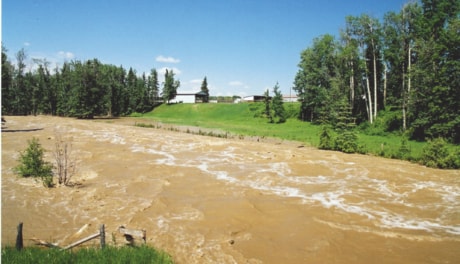Exactly five years ago (June 17, 2005), I headed west on a gorgeous, sunny morning to catch my traditional Fathers’ Day trout.
At the Penhold bridge, where Red Deer River water was flowing over the pavement, I discovered that, along with most Albertans, I had been blind-sided by what soon came to be known as the 200-Year-Flood.
At the viewpoint above the Dickson Dam, dozens of locals were taking pictures of the flooded valley below and the 10 metre standing waves at the bottom of the usually dry dam spillway. Just as I was about to head home skunked, I got a cellphone call from Herself relaying a message from a long time resident near the Stump Ranch that I should get out there if I could, to witness the sight of a lifetime. On the way west, near the junction of the North and South Raven Rivers, Hwy 54 had become a causeway as the South Raven pushed the North backwards, forming a huge lake of the little river’s entire valley and pushing the entire North Raven backwards, reversing it westerly down Clear Creek and into the Clearwater River. I had only seen the North Raven flowing backwards once before, in early July, 1970.
At Clearwater Trading, the Clearwater River was a brown and terrifying torrent.
Farther north and west, traffic was being stopped both sides of a bridge that was nearly awash over Prairie Creek, as brown water roared over the pavement. Ironically there was a good flight of golden stoneflies vainly trying to deposit eggs on the rushing mud.
Our lower hay field was a river as wide as the Red Deer, with only the tips of the streamside fence posts visible. As the water receded in following days, I searched the remaining puddles in vain for stranded trout to rescue. From 15 to 20 cm of rain had fallen in only 18 hours, in addition to the four cm the previous week, all added to the runoff starting from a heavy winter snow pack. By carefully navigating the waters on a back road in 4WD, I was able to get into the Stump Ranch to confirm the cabin was still there, as it should, being 10 meters or so above the creek’s ordinary high water mark.
Recently Alberta’s media has been heavily into Fifth Anniversary retrospectives of the 200-Year-Flood of 2005. A government report on its causes and effects has never been released, and victims of severe flood damage contend nothing is being done to prevent it happening again. The government asserts that it is so, quietly, doing good stuff in the background, mostly involving more effective ways of identifying and surveying flood plains and preventing municipalities and people from developing and building on them.
What is painfully obvious to outdoors people generally, is that rampant, uncontrolled clear cutting too close to the headwaters of our major watersheds is a prime factor leading to fast, heavy, and muddy runoffs — like in the “Flood of the Century” in 1995 and the “200-Year Flood” just 10 years later — and nothing is being done to stop the practise and repair the heavy damage already done. A broad buffer of bush and trees on both sides of rivers and streams absorbs and slows runoff.
Anglers have become painfully aware in the past five years that the 2005 flood seriously damaged trout populations and the aquatic insect biomass in many of our rivers and streams, and that the trout and the bugs are being left to breed themselves back to prosperity — a process that usually takes nearly a decade — without any help whatever from Alberta Sustainable Resource Development.
It was almost eerie: just as I sat down to start this column, an email arrived with an account and pictures of an amazing effect of the 2005 flood. Early this June, an angler reported to the Red Deer SRD office that he had taken and released a “five foot” (outdoors people, generally, do not speak metric) sturgeon from the main pond at Riverbend Golf Course.
A picture of his convinced local biologists to investigate, and they set gillnets in the pond on June 9, catching some lake whitefish, and suckers, but also one 148 cm sturgeon (very close to five feet). They did not have a scale big enough, but the biologists, using the time-honoured length-girth formula, estimated the sturgeon’s weight at between 25 and 30 kg.
Among other scientific procedures, the biologists tagged the big fish as part of a South Saskatchewan Sturgeon project. Then they released the sturgeon back to the nearby Red Deer River, which, SRD senior fisheries biologist, Vance Buchwald, theorizes, stranded the prehistoric relic in the pond during the historic 2005 flood.
Bob Scammell is an award-winning outdoors writer living in Red Deer.
